-
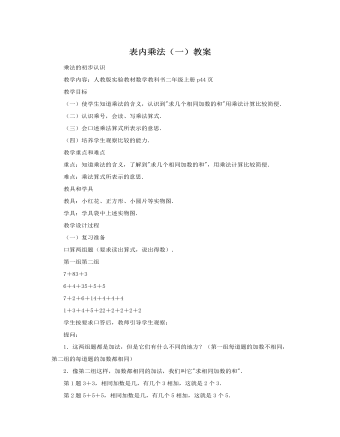
人教版新课标小学数学二年级上册表内乘法(一)教案
(6)交流。6的乘法口诀一共有几句?口诀中的第一个数与算式中的第二个因数相同,表示什么?口诀中的第二个数与算式的第一个因数相同,表示什么?相邻两句口诀的积相差几?哪几句难记一些?你用什么方法记呢?怎样记住"三六十八"、"四六二十四"两句口诀?教师在学生发言的基础上鼓励学生大胆说、想出不同记口诀的方法。(7)应用"做一做"第1题(学生半独立完成):①用6根小棒摆1个六边形;②摆2个六边形要用多少根小棒?你是怎样想的?(想口诀"二六十二"。)③运用所学的口诀口答摆4个、6个、3个、5个六边形所需要向小棒数。"做一做"第2题(独立完成):①将第2题改为填空题,在圆圈内填写正确的积;②口答得数,并说一说所用口诀。
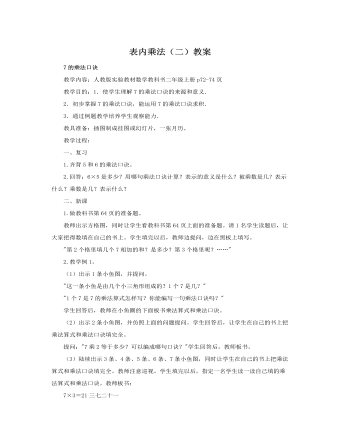
人教版新课标小学数学二年级上册表内乘法(二)教案
三、利用乘法口诀进行计算1.复习口诀的含义。任意挑出一句乘法口诀(两个因数不同的),让学生说说它表示什么意思。如"七八五十六",使学生知道它既表示8个7相加是56,又表示?个8相加是56。2.以游戏的方式开展用口诀进行计算的活动。(1)已知两个因数求积的游戏。方法是:请一位学生随意说出一个两位数,另一位学生则将这个两位数的十位数字与个位数字相乘,并算出结果,如果结果又是一个两位数,再将这个两位数的十位数字和个位数字相乘,直至结果是一位数或零。如,一位学生说:"79",另一位学生则口算:7X9=636X3=181X8=8;一位学生说:"58":另一位学生口算:5X8=404X0=0(告诉学生0和一个数相乘得零)一位学生报了3个数以后,互换角色进行。(2)已知积求两个因数的游戏。
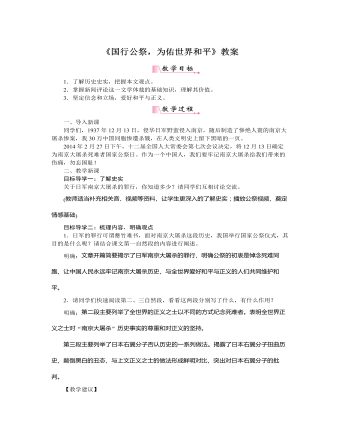
部编版语文八年级上册《国行公祭,为佑世界和平》教案
目标导学二:梳理内容,明确观点1.日军的罪行可谓罄竹难书,面对南京大屠杀这段历史,我国举行国家公祭仪式,其目的是什么呢?请结合课文第一自然段的内容进行阐述。明确:文章开篇简要揭示了日军南京大屠杀的罪行,明确公祭的初衷是悼念死难同胞,让中国人民永远牢记南京大屠杀历史,与全世界爱好和平与正义的人们共同维护和平。2.请同学们快速阅读第二、三自然段,看看这两段分别写了什么,有什么作用?明确:第二段主要列举了全世界的正义之士以不同的方式纪念死难者。表明全世界正义之士对“南京大屠杀”历史事实的尊重和对正义的坚持。第三段主要列举了日本右翼分子否认历史的一系列做法。揭露了日本右翼分子扭曲历史,颠倒黑白的丑态,与上文正义之士的做法形成鲜明对比,突出对日本右翼分子的批判。
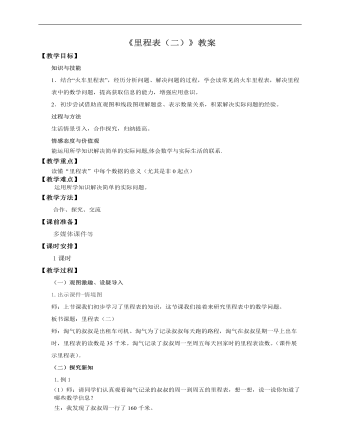
小学数学北师大版三年级上册《第五课里程表(二)》教案说课稿
(一)观图激趣、设疑导入 1.出示课件-情境图师:上节课我们初步学习了里程表的知识,这节课我们接着来研究里程表中的数学问题。板书课题:里程表(二)师:淘气的叔叔是出租车司机。淘气为了记录叔叔每天跑的路程,淘气在叔叔星期一早上出车时,里程表的读数是35千米。淘气记录了叔叔周一至周五每天回家时的里程表读数。(课件展示里程表)。(二)探究新知1.例1(1)师:请同学们认真观看淘气记录的叔叔的周一到周五的里程表,想一想,说一说你知道了哪些数学信息?生:我发现了叔叔周一行了160千米。 师:同学们他说找到数学信息对吗?生:160千米不是星期一的行驶里程,应该是星期一晚上里程表上的读数。 星期二里程表上的读数是350,。生:。。。。师:同学们找的数学信息非常多,非常全面。(2)小组讨论交流:淘气根据题意画了一个图,你看懂了吗?与同伴说一说。

人教版新目标初中英语八年级上册How do you get to school教案2篇
Step Ⅶ Role play ( Work on 1b)1. First ask two students to read the dialogue to the class.Sa: How do you get to school?Sb: Well, I ride my bike to the subway station. Then I take the subway.2. Now work with a partner.Suppose you use two kinds of transportation to get to school \Hangzhou\Beijing... (bus, train, subway, walking, bike, etc.) Tell how you get there. You may use the phrases in 1a.3. Then ask different pairs of students to present their conversations to the class.Step ⅧListening1. Work on 2a(1) First ask students to read the list of information that Thomas wants to know.…where Nina lives.…how far from school she lives.…how long it takes to get to school.…how she gets to school.…what she thinks of the transportation.(2) Tell students what transportation and bus stop mean.bus stop 汽车站 transportation n. 运送;运输Then tell students we'll hear a recording. Please put a checkmark in front of each thing that Thomas wants to know.(3) Now play the recording for students.( Have students pay attention to the sample answer.) (4) Then correct the answers.
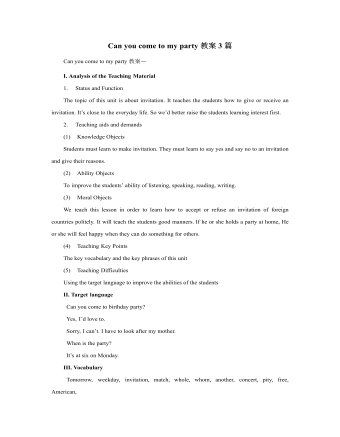
人教版新目标初中英语八年级上册Can you come to my party教案3篇
Step 3 (3b)First, tell the students when we talk about our future plans, we often use: I’m+verb+ing When we talk about what we must do, we use have to. Ask the students to fill in the blanks in 3b. The answers are: shopping, go to see, a test, I’m going, my family. Step 4 (3c)Let the students write an e-mail message to a friend. Say why you can’t visit next. Before the exercise, ask the students to give some possible answers and write them on the blackboard. So the students will feel easy to finish the writing exercise. After they finish it, Let them to correct it in groups first. Each group chooses theirs best one to read in front of the whole class. Step 5 ( planning a party )First read the conversation in the box together. Then ask the students to turn to page 88.Write down everything you have to do next week. Write in all the things you have to do . Ask the students to look at the list. Ask them “What day are you free?” This is when you can have your party. Step 6 (Self check 1 )Let the students to fill in the blanks with the words given. Change the forms of the words if possible. Then make their own sentences. The answers are: visit, playing, have to, study, comeStep 7 (Self check 2)Imagine you are Marie. Read the information and look at your schedule. Write replies to the invitation.
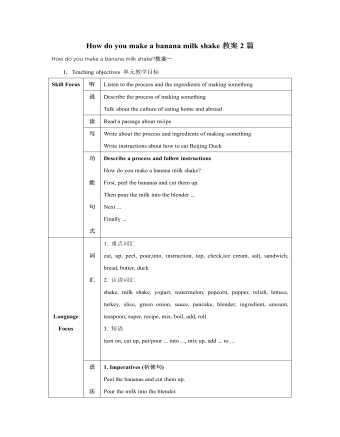
人教版新目标初中英语八年级上册How do you make a banana milk shake教案2篇
1. First, ... then, ... next, ... finally, ...首先,……然后,……接着,……最后,……这是英语中表达做某事的步骤的一种说法。如果步骤较多,还可以说:first-next-after that-later on-finally/at last通常你会听到说英语国家的人在说 first, next, then, finally 和后面的内容时,他们会做一些停顿。这样就能提前告诉听者接下来讲的是一系列的步骤。这一点在朗读和听力中应特别注意。2. how many, how much均为疑问词,同是“多少”,但用法不同。请看:how many修饰可数名词复数,how much修饰不可数名词。但在用法上,同学们常犯如下错误:1) [误] How many are there bananas on the table?[正] How many bananas are there on the table?[析] how many, how much 中的many,much是形容词,常修饰名词作定语,故后面跟名词。2) [误]How much tea are there on the table?[正]How much tea is there on the table?[析] how much修饰不可数名词时,谓语动词用单数。how many与how much的区别可简记为:前how many:问“多少”,复数名词后面跑;how much问“多少”,不可数名词单数好。前者答语用基数词,后者答语用数量关系。
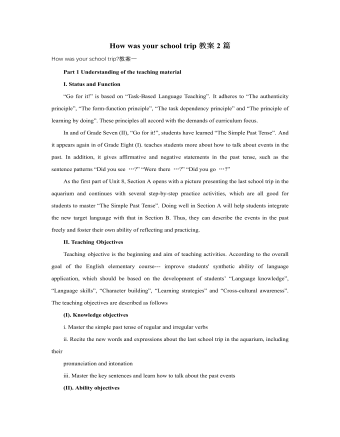
人教版新目标初中英语八年级上册How was your school trip教案2篇
“Go for it!” is based on “Task-Based Language Teaching”. It adheres to “The authenticity principle”, “The form-function principle”, “The task dependency principle” and “The principle of learning by doing”. These principles all accord with the demands of curriculum focus.In and of Grade Seven (II), “Go for it!”, students have learned “The Simple Past Tense”. And it appears again in of Grade Eight (I). teaches students more about how to talk about events in the past. In addition, it gives affirmative and negative statements in the past tense, such as the sentence patterns “Did you see …?” “Were there …?” “Did you go …?” As the first part of Unit 8, Section A opens with a picture presenting the last school trip in the aquarium and continues with several step-by-step practice activities, which are all good for students to master “The Simple Past Tense”. Doing well in Section A will help students integrate the new target language with that in Section B. Thus, they can describe the events in the past freely and foster their own ability of reflecting and practicing. II. Teaching ObjectivesTeaching objective is the beginning and aim of teaching activities. According to the overall goal of the English elementary course--- improve students' synthetic ability of language application, which should be based on the development of students’ “Language knowledge”, “Language skills”, “Character building”, “Learning strategies” and “Cross-cultural awareness”. The teaching objectives are described as follows(I). Knowledge objectivesi. Master the simple past tense of regular and irregular verbsii. Recite the new words and expressions about the last school trip in the aquarium, including their pronunciation and intonation

人教版新目标初中英语八年级上册Could you please clean your room教案3篇
一、 教学内容Section A 1a----1c二、 教学目标1.学习词汇do the dishes, make the bed, take out the trash, fold the clothes, do the laundry, sweep the floor, clean the living room.2.句型 Could you please clean your room? Yes, sure.三、 教学准备 学生预习本单元所有的词汇多媒体课件 活动表 奖品四、 教学过程Pre-task1. Warming upEnjoy ourselves. Watch cartoon Cinderella. 看动画片段《灰姑娘》导如入本课话题和新词汇“chores”美丽善良的鬼姑娘因继母的嫉妒,每天得做所有的家务。片段的主题使学生联想到本课的话题。2. learn new words and phrasesLook! What is she / he dong? 看图学习动词词组do chores, do the dishes, make the bed, take out the trash, fold the clothes, do the laundry, clean the living room.3. Guessing game.What is she doing ? 4. Pair work. 1a, Do you do these things at home? Write “Y” for “yes” and “N” for “no”.5. Listening . 1b , Peter’s chores or Mom’s chores?理解目标语Could you please clean your room? Yes, sure.Write “M” for Mom’s chores, “P” for Peter’s chores in the chart.6. PairworkLook at the picture,Ask your partner to do the chores that you see. 7. Interview Who is the most able at home? 1) What chores do you do at home? How often do you do the chores? Work in four, interview each of the students in the group, fill in the chart.
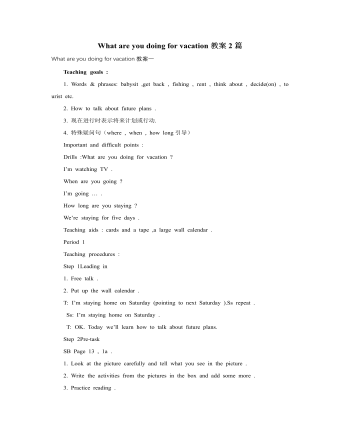
人教版新目标初中英语八年级上册What are you doing for vacation教案2篇
Teaching goals : 1. Words & phrases: babysit ,get back , fishing , rent , think about , decide(on) , tourist etc. 2. How to talk about future plans . 3. 现在进行时表示将来计划或行动. 4. 特殊疑问句(where , when , how long引导) Important and difficult points : Drills :What are you doing for vacation ? I’m watching TV . When are you going ? I’m going … . How long are you staying ? We’re staying for five days . Teaching aids : cards and a tape ,a large wall calendar . Period 1 Teaching procedures : Step 1Leading in1. Free talk . 2. Put up the wall calendar . T: I’m staying home on Saturday (pointing to next Saturday ).Ss repeat . Ss: I’m staying home on Saturday . T: OK. Today we’ll learn how to talk about future plans. Step 2Pre-task SB Page 13 , 1a . 1. Look at the picture carefully and tell what you see in the picture . 2. Write the activities from the pictures in the box and add some more . 3. Practice reading . Step 3While-task1. Using the activities we write in 1a to make conversations .For example :What are you doing for vacation ? I’m visiting my uncle . 2. Pairwork .Practice in pairs . 3. 用第三人称练习对话.
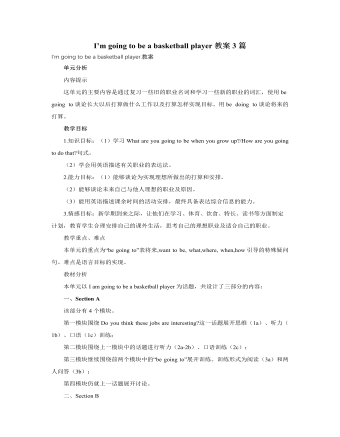
人教版新目标初中英语八年级上册I’m going to be a basketball player教案3篇
教学目标1.知识目标:(1)学习What are you going to be when you grow up?/How are you going to do that?句式。(2)学会用英语描述有关职业的表达法。2.能力目标:(1)能够谈论为实现理想所做出的打算和安排。(2)能够谈论未来自己与他人理想的职业及原因。(3)能用英语描述课余时间的活动安排,最终具备表达综合信息的能力。3.情感目标:新学期到来之际,让他们在学习、体育、饮食、特长、读书等方面制定计划,教育学生合理安排自己的课外生活,思考自己的理想职业及适合自己的职业。教学重点、难点本单元的重点为“be going to”表将来,want to be, what,where, when,how引导的特殊疑问句。难点是语言目标的实现。教材分析本单元以I am going to be a basketball player为话题,共设计了三部分的内容:一、Section A该部分有4个模块。第一模块围绕Do you think these jobs are interesting?这一话题展开思维(1a)、听力(1b)、口语(1c)训练;
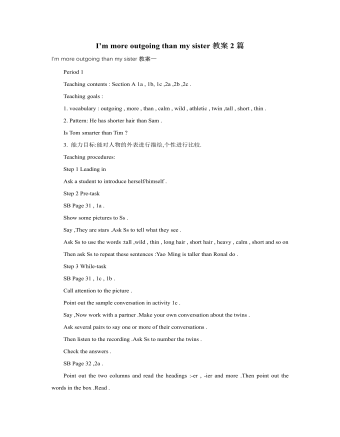
人教版新目标初中英语八年级上册I’m more outgoing than my sister教案2篇
1 交通工具的比较此活动为小组活动。学生通过讨论找出到达某一城市可乘坐的各种交通工具,并选择最佳出行方式。Teacher:We’re going to Shanghai. How many ways can we use to get there? Yes, there are four ways: by bus, by plane, by train, by ship. Please discuss how you are going to get there.操作建议:(1)学生以小组为单位展开活动,谈论本组所选择的交通工具。(2)各组选代表向全班汇报,阐述本组所选择的交通工具的利和弊。完成任务所需要的语言结构:We can go there by ship. It’s more comfortable and cheaper than any other transportation.We can go there by bus. It’s cheaper but it takes longer time.2 哪个城市更合适?此活动具有挑战性。假设中国要举行2014年世界杯足球赛,分别从历史,人文,天气等方面对各城市(北京,大连,上海,昆明)进行比较,选择最佳举办城市。T: Imagine China is holding the 2014 FIFA World Cup. Which city do you think is the best for the World Cup, Beijing, Dalian, Shanghai or Kunming? Let’s work in groups. If you choose Beijing, please join the Team Red. If you chose Dalian, please join the Team White. If you choose Shanghai, please join the Team Blue. If you choose Kunming, please join the Team Green. Please show us its advantages. Then let’s see which team will win.
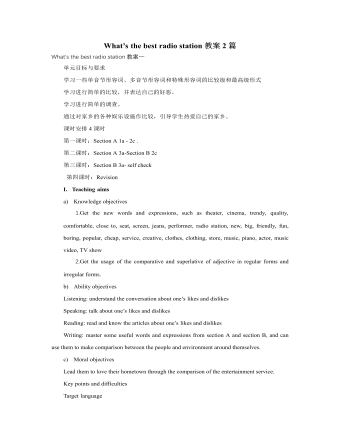
人教版新目标初中英语八年级上册What’s the best radio station教案2篇
教学重点和难点:运用所掌握的语言描述,比较不同地点的特点。在练习中学习掌握英语比较级和最高级的用法。课前准备分配小组,每组五至六人。通过上网或翻阅报刊杂志等方法,确定旅游线路,做出基本的旅游计划。教学设计:本节课流程图 学法指导:1.由于这是一堂新课,在教学中应注意面向全体,发挥学生的主体性,引导学生积极参与,激发学生的求知欲和学习积极性,指导学生积极思维,主动获取知识,养成良好的学习方法。逐步学会独立解决问题。总之要尽可能调动学生的非智力因素促进智力因素的发展。教法选择:1.电化教学法2.课堂讨论法3.任务型教学法采用这些方法的目的是为了充分调动学生的学习积极性,使学生变被动学习为主动学习。通过电脑形象的演示,加强印象,提高兴趣,突破难点,提高教学效率,进而增大教学的容量和信息量。充分体现教师为主导,学生为主体的教学原则。
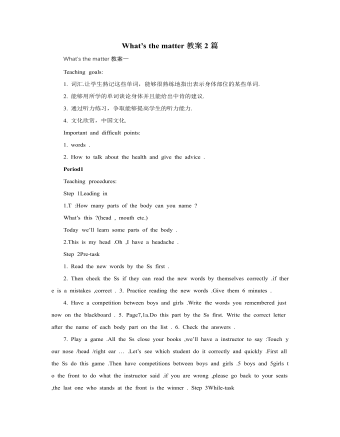
人教版新目标初中英语八年级上册What’s the matter教案2篇
She shouldn’t go to the party tonight.Step7. TaskT: You know, there are lots of problems in our life. If you are a doctor, please tell us how to solve the problem. I will divide you into 9 groups. Please work in groups. And then choose one of you to report your ideas.The following are the problems:I have a toothache.I am hungry. I have a sore throat.I am stressed out. I have a sore back.I am tired. I can’t sleep.I have a cold. I have a headache.Report: If you have a headache, you should go to bed early. You should see the doctor. You should eat some medicine. You shouldn’t wash your face with cold water.You shouldn’t sleep late.You shouldn’t swim.…..T encourages the students to give advice as much as possible.Homework:1. Chose one of the problems, and write down your advice2. Copy the new words这一步是用于热身的,同时也可以让他们复习一部分的表示人体部位的单词,扩充知识.学习语言的过程也是一个不断积累的过程,复习旧知识,增添新知识.通过小游戏,强化学生对Does she/he have…这个句子的运用能力.通过复习,自然的引到下面新知识的学习。充分利用表格,由句子到对话,再到文章,让学生循序渐进. 提高学生的综合语言运用能力,运用以前学过的知识来解决身边的问题.Period 5 (Section B 3a—3c, selfcheck)教学内容与分析:
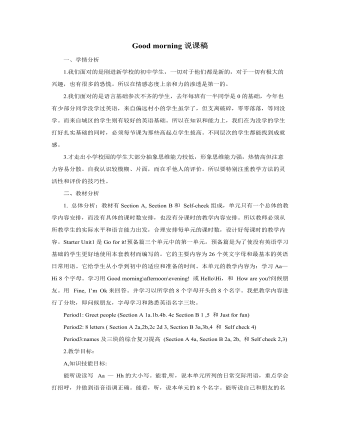
人教版新目标初中英语七年级上册Good morning说课稿
1.课堂活动中的竞赛制:以记奖评优的形式无声的评价每一个活动,包括个体和小群体。在第一课时评最佳演员和导演奖,第二课时评最佳团体奖,既节约时间又明确有效。使学生能提高语言质量,增强参与意识,提高学习兴趣。2. 教师课堂上语言、表情激励制:在课堂活动中教师要乐于 、善于用激励性语言。从good, super, smart, excellent , great ,wonderful等,用微笑,皱眉,摇头、点头等身体语言对于学生的评价是方便又有效的途径。3.课后作业评价:口头作业在第二天课堂上表演,接受全体同学的评价。笔头作业有教师批阅,以评语的方式出现。优秀作业予以展出或交流。积极地肯定和鼓励学生是我们评价的重要目的之一。4.单元结束后综合性评价:除了笔试以外,也可以根据学生实际开展丰富的活动,如:调查报告、小品表演、专题演讲等。
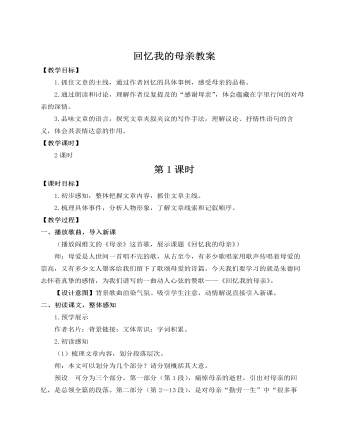
人教部编版语文八年级上册回忆我的母亲教案
提起了母亲,朱德将军满脸温情和悲痛。生他的时候,母亲不过二十刚过的年龄。她比一般妇女要高大一些,强壮一些,裤子和短褂上,左一块右一块都是补丁,两只手上突显着粗粗的血管,由于操劳过度,面色已是黝黑,蓬蓬的头发在后颈上挽成一个发髻,两只大大的褐色眼睛里充满了贤惠,充满了忧愁。(摘自史沫特莱《伟大的道路》)毛泽东写给朱德母亲的挽联毛泽东曾给朱德的母亲写了一副挽联:“为母当学民族英雄贤母,斯人无愧劳动阶级完人。”毛泽东在这副挽联中高度赞扬了朱德母亲的高尚品质,高度评价了他的革命战友朱德的革命精神。上联,“为母”是指做母亲。是的,母亲是儿女的第一任老师。那么,怎样才能做一个合格的母亲呢?毛泽东接下来告诉人们“当学民族英雄贤母”,告诉天下所有做母亲的人,要学习民族英雄——朱德贤惠的母亲。上联的重点在于赞子,既悼母又赞子,一语双关。
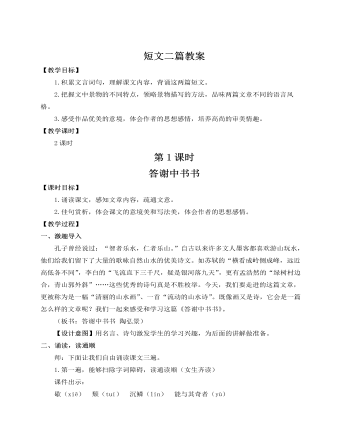
人教部编版语文八年级上册短文二篇教案
陶弘景隐居茅山时期,仍然关心社会的发展,希望社会稳定,天下百姓都能安居乐业。梁武帝很感激陶弘景给予的有力支持,亲提御毫,写了一封情真意切的御诏,文曰:“山中何所有?卿何恋而不返?”盼望陶弘景出山辅政,重列朝班。然而陶弘景下定了不出山的决心,他先写了一首诗,后画了一幅画作为回答。诗为《诏问山中何所有赋诗以答》:“山中何所有,岭上多白云。只可自怡悦,不堪持赠君。”画的内容是:两头牛,一头散放水草之间,自由自在;一头套着金笼头,被人用牛绳牵着,用牛鞭驱赶。梁武帝看了诗和画,领会了他的用意,就不再强迫他出来做官了。但是“国家每有吉凶征讨大事,无不前以咨询”,故当时人称陶弘景为“山中宰相”。林语堂《苏东坡传》中这样评价苏轼
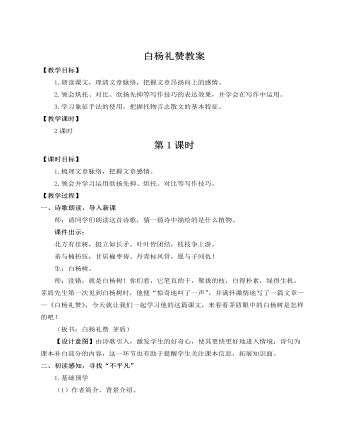
人教部编版语文八年级上册白杨礼赞教案
【设计意图】帮助学生理解象征手法,明确本体与象征体的联系,体会作者的情感。通过朗读加深学生对重点句子的理解,让这种精神内化为个人力量。三、练习象征手法的运用请同学们说一说这些形象可以象征什么?课件出示:落叶、荷花、蜡烛、梅花、翠竹、鹰、太阳、孔雀、牛生答:蜡烛燃烧自己照亮别人,可以象征舍己为人的品质,可以象征教师。……师:大家的思路逐渐被打开了,请同学们拿出纸和笔开始写作。注意:本文前半部分是对白杨树的自身形象进行描绘,再通过联想和想象赋予它一定的象征意义,所以同学们不要一开始就写什么物象征什么。结束语:同学们,一篇优秀的散文,就如一幅无形的画,又恰似一首读不尽的诗,茅盾先生的散文达到了如诗如画的艺术境界,白杨树在特定的历史时期被赋予了特定的内涵。让我们再次以茅盾先生写的小诗《题白杨图》作结,向白杨树的精神致敬,向中华儿女身上的正直、质朴、紧密团结、力求上进、坚强不屈的精神和意志致敬!(师生同读教材P81《题白杨图》一诗)
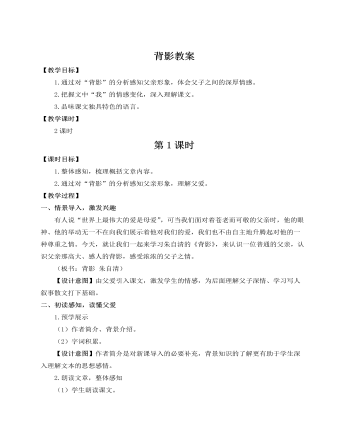
人教部编版语文八年级上册背影教案
一提到朱自清,大家脑海里闪现出的便是《荷塘月色》《背影》《匆匆》等美文。位于昆明司家营的朱自清旧居,这座“一颗印”老宅不仅承载着七十多年前以朱自清为代表的清华文科研究所师生的家国情怀,也记录着朱自清那些不为人知的故事。这些故事,将撕开朱自清身上“散文家”“诗人”“学者”“民主战士”的标签,让大家看到一个不一样的朱自清!“时尚达人”朱自清1942年冬天,昆明天气格外寒冷,如何温暖过冬成了朱自清头疼的大问题。身上的旧皮袍已经缝补了许多次,早已抵挡不住瑟瑟寒风。掏掏口袋,发现生活费都够呛,更不要说缝制新棉袍,于是朱自清做了一个决定。趁着龙头街赶街的日子,朱自清给自己挑了一件赶马人穿的、制作粗糙、价格便宜的毡披风。朱自清一毡多用,出门时,他就将毡披风披在身上御寒,晚上睡觉时,毡披风一脱就当被褥。朱自清上街,里边穿西装,外边穿赶马人的毡披风,给联大师生留下了深刻的印象。这件毡披风由于太过显眼,被誉为“联大三绝”,也成了他教授生活清贫的标志,以至于后来多次出现在回忆朱自清的朋友的笔下。
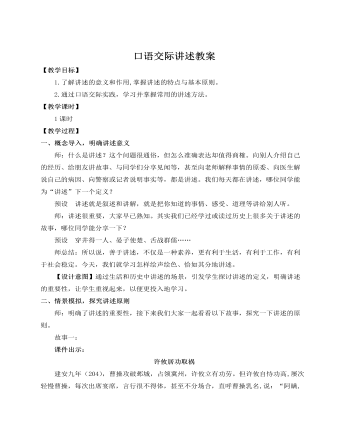
人教部编版语文八年级上册口语交际讲述教案
课件出示:(1)养成爱听、多听、会听的好习惯,比如多听新闻、听演讲、听别人说话等,从而形成语言智慧的丰富源泉。(2)多看电影、书报、电视访谈节目,还可以看现实生活中各种生动而感人的场景,为说积累素材。(3)多背诗词、格言、谚语等,能在情感上受到滋润、熏陶,慢慢形成自己正确而生动的语言。(4)多说才能使你的语言表达能力迅速提高。3.课后作业师:课后,各学习小组可以从课本P20“口语实践”六个话题中选择一两个,讲故事给你的同桌听。结束语:良言一句三冬暖,恶语伤人六月寒。讲述不仅仅是一门学问,更是一门艺术。讲述能力的提高仅仅通过一节课的学习是不够的,还希望同学们在日常的学习生活中多沟通,多交流。通过练习,你定能妙语连珠、侃侃而谈,舌灿莲花。





















